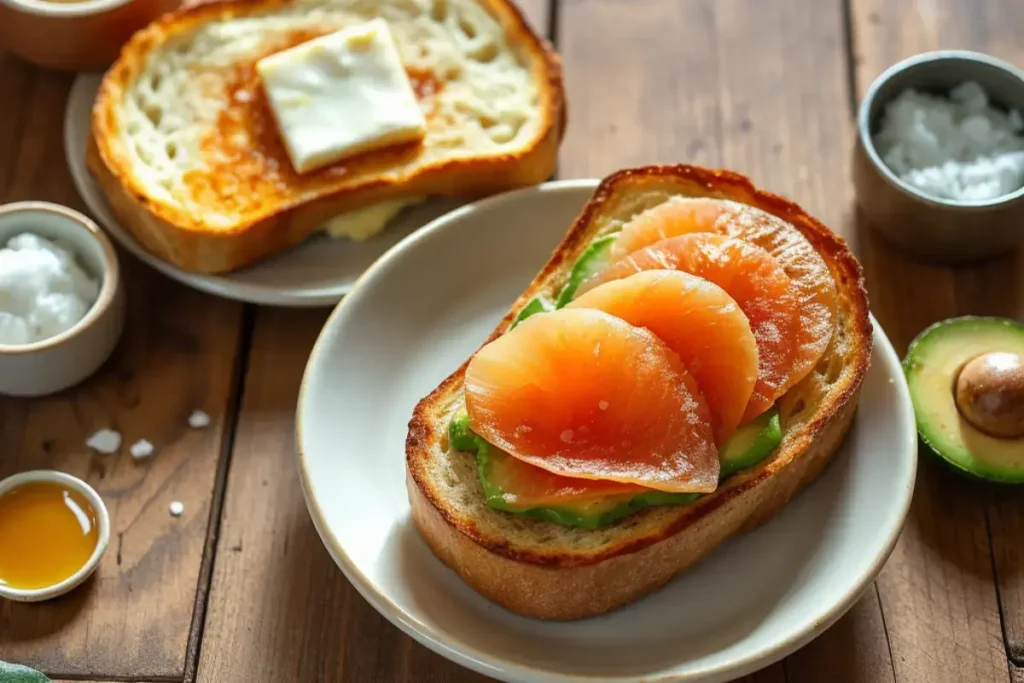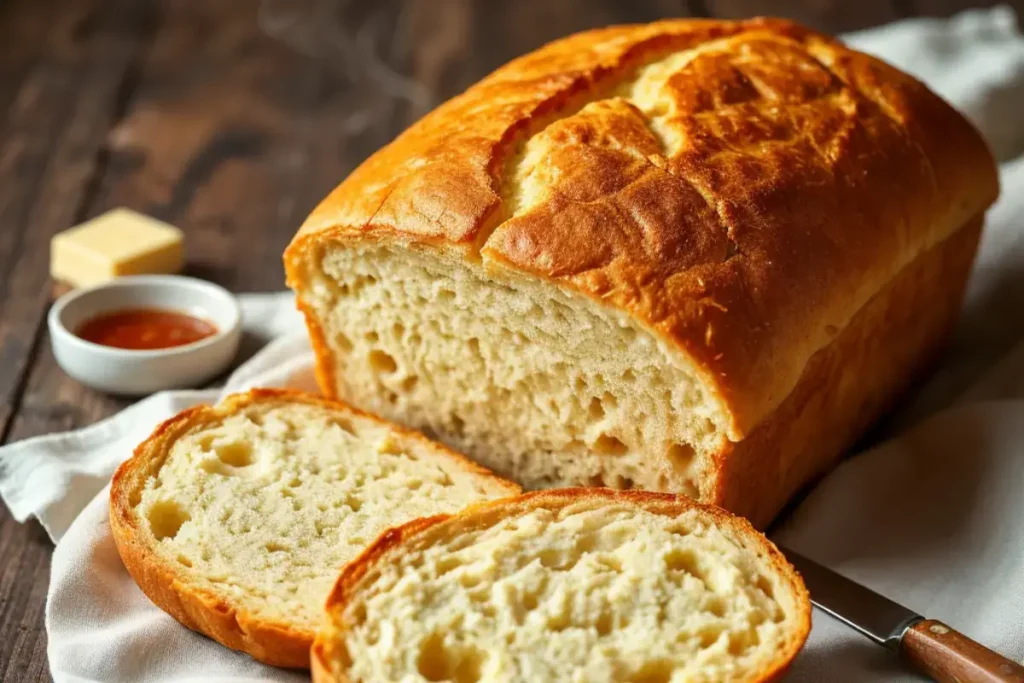When I first discovered this cottage cheese bread recipe, I was instantly intrigued. It sounded like the perfect fusion of health and comfort—two things that often don’t go hand in hand. As someone who enjoys exploring healthier alternatives in baking, this recipe immediately caught my attention. The promise of a tender, protein-packed loaf that could be enjoyed in various ways was simply irresistible.
Cottage cheese bread is not just another bread recipe; it’s a versatile creation that can be tailored to fit any occasion. Whether you want to enjoy it fresh out of the oven with a slather of butter, toast it for a quick breakfast, or use it as a base for a gourmet sandwich, like these Thin-Sliced Chicken Breast Recipes, this bread has got you covered. The subtle tang from the cottage cheese, combined with its soft texture, makes it a delightful addition to any meal.

One of the main reasons I love this bread is because it offers a nutritional punch that regular bread lacks. Cottage cheese is a powerhouse of protein, and incorporating it into bread means you’re getting more than just empty carbs. Plus, it’s lower in fat compared to many other cheese-based breads, making it a healthier option for those watching their calorie intake.
Ingredients for Your Cottage Cheese Bread Recipe
To make this cottage cheese bread recipe, you’ll need the following ingredients. The great thing about cottage cheese bread is that it’s made with simple, everyday ingredients that you probably already have in your kitchen.

Essential Ingredients
- 3 cups all-purpose flour: This forms the base of the bread. If you’re looking to make the loaf heartier, you can substitute part or all of the flour with whole wheat flour.
- 1 packet active dry yeast (about 2 1/4 teaspoons): Yeast is the leavening agent that gives the bread its rise.
- 1 cup cottage cheese: The star ingredient that adds moisture and protein to the bread. You can use either full-fat or low-fat, depending on your dietary preferences.
- 1/4 cup warm water (around 110°F): Helps activate the yeast.
- 2 tablespoons honey: Adds a touch of sweetness. You can substitute with sugar or a sugar alternative if desired.
- 1/4 cup unsalted butter (melted): Provides richness and flavor.
- 1 teaspoon salt: Enhances the overall flavor of the bread.
- 2 large eggs (room temperature): Adds structure and richness to the dough.
Alternatives for Dietary Restrictions
If you’re catering to specific dietary needs, there are a few simple swaps you can make:
- Gluten-Free Option: Use a 1:1 gluten-free flour blend. Keep in mind that gluten-free doughs tend to be stickier, so you might need to adjust the amount of liquid.
- Dairy-Free Option: Substitute the cottage cheese with a dairy-free version made from almonds or cashews. You can also replace the butter with a plant-based alternative.
- Sugar-Free Option: Use a sugar substitute like stevia or erythritol in place of honey.
Importance of Ingredient Quality
When it comes to baking, the quality of your ingredients can make all the difference. I always recommend using organic, unbleached flour for a cleaner flavor and better texture. The same goes for cottage cheese—opt for a brand that uses high-quality milk without added preservatives. Trust me, these small choices elevate the taste of your bread.
How to Make the Best Cottage Cheese Bread Recipe
Baking cottage cheese bread is a rewarding experience, especially when you pull that golden, fragrant loaf out of the oven. This cottage cheese bread recipe requires careful attention to the yeast and dough preparation.
Preparation
- Activate the Yeast: Start by dissolving the yeast in warm water. Let it sit for about 5 minutes until it becomes frothy. This is a crucial step because it ensures that your yeast is alive and ready to leaven the bread. If your yeast doesn’t foam up, it might be expired or the water temperature could be too hot or too cold.
- Mix the Wet Ingredients: In a large bowl, combine the cottage cheese, melted butter, honey, and eggs. Stir until everything is well mixed. If your cottage cheese is particularly watery, you might want to drain it first to avoid adding too much moisture to the dough.
- Combine the Dry Ingredients: In another bowl, whisk together the flour and salt. Gradually add the dry ingredients to the wet mixture, stirring until a dough forms. The dough should be soft and slightly sticky but manageable.
- Knead the Dough: Turn the dough onto a floured surface and knead it for about 8-10 minutes. Kneading is essential as it develops the gluten, which gives the bread its structure. The dough should become smooth and elastic. If it’s too sticky, sprinkle in a little more flour as needed.

Baking Instructions
- First Rise: Place the dough in a greased bowl, cover it with a clean kitchen towel, and let it rise in a warm place for about an hour, or until it has doubled in size. I often use my oven’s proofing setting or simply let the dough rise on the countertop if the kitchen is warm enough.

- Shape the Dough: Once the dough has risen, punch it down to release the air. Shape it into a loaf and place it in a greased loaf pan. If you want to get creative, you can also shape the dough into rolls or a braid.
- Second Rise: Cover the dough again and let it rise for another 30-45 minutes. This second rise will help the bread develop a better texture and flavor.
- Bake the Bread: Preheat your oven to 350°F (175°C). Bake the bread for 30-35 minutes, or until the top is golden brown and the bread sounds hollow when tapped. If you want a more precise measure, use an instant-read thermometer to check that the internal temperature is around 190°F (88°C).
Post-Baking Tips
- Cooling the Bread: Let the bread cool in the pan for about 10 minutes before transferring it to a wire rack. This allows the bread to set and makes it easier to remove from the pan. Letting it cool completely on a wire rack ensures that the bottom doesn’t become soggy.
- Serving Suggestions: This bread is incredibly versatile. Enjoy it warm with a pat of butter, toast it for breakfast, or use it as the base for a sandwich. It pairs well with both sweet and savory toppings—try it with jam, honey, or even avocado, or alongside these 4-Ingredient Chicken Breast Recipes.

- Storing the Bread: If you’re not planning to eat the bread within a couple of days, slice it and store it in the freezer. This way, you can enjoy a fresh slice whenever you like. Just pop it in the toaster, and it’s as good as new.
Variations of Cottage Cheese Bread
While the classic cottage cheese bread recipe is delicious on its own, I love experimenting with different variations to keep things interesting. One of my favorite twists on this cottage cheese bread recipe is the herb-infused variation.
Savory Variations of This Cottage Cheese Bread Recipe
- Herb-Infused Bread: Add 2-3 tablespoons of chopped fresh herbs like rosemary, thyme, or chives to the dough. These herbs not only add flavor but also give the bread a beautiful aroma. I particularly love the combination of rosemary and chives—they complement the tanginess of the cottage cheese perfectly.

- Cheesy Delight: For a richer, more indulgent loaf, mix in 1/2 cup of shredded cheese—cheddar or parmesan work wonderfully. The cheese melts into the bread as it bakes, creating delicious pockets of gooey goodness. This variation is perfect for making grilled cheese sandwiches or serving alongside a hearty soup.
Sweet Variations
- Honey Cinnamon Swirl: If you’re in the mood for something sweet, this variation is a must-try. Before the final rise, roll out the dough into a rectangle, brush it with melted butter, and sprinkle it with a mixture of cinnamon and sugar. Roll it up, place it in the loaf pan, and let it rise. The result is a beautifully swirled loaf with a sweet, spiced flavor.
- Fruit-Studded Bread: For a fruity twist, fold in 1/2 cup of dried fruits like raisins, cranberries, or chopped apricots. The dried fruit adds a burst of sweetness and a chewy texture that contrasts nicely with the soft crumb of the bread. This variation is perfect for breakfast or tea time.
These variations show just how versatile cottage cheese bread can be. Whether you’re in the mood for something savory or sweet, there’s a version of this bread that’s sure to satisfy your cravings.
Health Benefits and Nutritional Value
One of the reasons I love cottage cheese bread is because it’s not just delicious—it’s also packed with nutrients. Here’s a breakdown of why this bread is a healthier choice compared to traditional white bread.
Nutritional Profile
Cottage cheese bread is higher in protein than most other types of bread, thanks to the addition of cottage cheese. Protein is essential for muscle repair and growth, and having a protein-rich bread option is great for those looking to increase their intake without consuming too many carbs.
In addition to protein, this bread provides a good balance of carbohydrates and fats, making it a well-rounded option for any meal. If you choose to use whole wheat flour, you’ll also benefit from the extra fiber, which is important for digestive health.
Here’s a rough nutritional breakdown per slice (assuming the loaf is sliced into 12 pieces):
- Calories: 150
- Protein: 6g
- Carbohydrates: 20g
- Fat: 5g
- Fiber: 2g
- Sugar: 3g
These values can vary slightly depending on the specific ingredients you use, such as the type of flour or the fat content of the cottage cheese. What’s great about this bread is that it offers a more balanced macronutrient profile compared to traditional white bread, making it a healthier choice that doesn’t sacrifice flavor or texture.
Benefits for Specific Diets
Cottage cheese bread is not only tasty but also adaptable for various dietary needs. Here’s how it can fit into specific diet plans:
- Low-Carb Diet: While this bread isn’t strictly low-carb, it’s lower in carbs than many traditional breads, especially if you substitute a portion of the flour with almond flour or another low-carb alternative. The higher protein content from the cottage cheese also makes it a better option for those following a lower-carb lifestyle.
- High-Protein Diet: For those looking to increase their protein intake, cottage cheese bread is an excellent choice. Each slice offers a significant protein boost, thanks to the cottage cheese. It’s a great way to incorporate more protein into your diet without having to rely solely on meat or protein shakes.
- Balanced Diet: If you’re following a balanced diet, this bread fits right in. It provides a mix of complex carbohydrates, healthy fats, and protein, making it a nourishing option for any meal of the day.
Comparison with Other Breads
Compared to other types of bread, such as whole wheat or white bread, or even Sourdough Sandwich Bread, cottage cheese bread offers a unique blend of benefits:
- White Bread: While white bread is light and fluffy, it’s often lacking in nutrients. Cottage cheese bread provides more protein and healthier fats, making it a more nutritious choice.
- Whole Wheat Bread: Whole wheat bread is high in fiber but can sometimes be dense and dry. Cottage cheese bread combines the benefits of whole wheat with the softness of white bread, resulting in a loaf that’s both hearty and tender.
FAQs Section
As I’ve shared this recipe with friends and family, several questions have come up. Here are some of the most common ones, along with my answers.
Can I Substitute Cottage Cheese with Other Dairy Products in the Bread Recipe?
Absolutely! If you’re not a fan of cottage cheese or simply don’t have it on hand, there are several alternatives you can use. Ricotta cheese is a great substitute and will give you a similar texture and flavor. Greek yogurt is another option; it will add a bit more tang to the bread, but it works well and provides a similar protein content. Just be sure to adjust the consistency if needed, as some dairy products might be thicker or thinner than cottage cheese.
How Long Can I Store Cottage Cheese Bread?
This bread stores quite well. At room temperature, it will stay fresh for up to three days if kept in an airtight container or wrapped tightly in plastic wrap. If you need to store it for longer, I recommend freezing it. Slice the bread first, wrap each slice individually in plastic wrap, and then place them in a freezer bag. The bread will keep for up to three months in the freezer, and you can simply pop a slice in the toaster when you’re ready to enjoy it.
What Is the Best Way to Serve Cottage Cheese Bread?
There are so many ways to enjoy cottage cheese bread. Fresh out of the oven, it’s delicious with a pat of butter or a drizzle of honey. It also makes fantastic toast—crispy on the outside and soft on the inside. For a savory option, I love using it as a base for sandwiches. Its soft texture and subtle tang complement a wide range of fillings, from classic ham and cheese to more gourmet options like avocado and smoked salmon.
Is Cottage Cheese Bread Suitable for a Low-Carb Diet?
While cottage cheese bread isn’t as low in carbs as something like a keto-friendly almond flour bread, it’s still a better option than traditional bread if you’re watching your carb intake. The addition of cottage cheese increases the protein content, which can help balance out the carbs. For a lower-carb version, you can try substituting part of the flour with almond flour or another low-carb flour alternative. Keep in mind that this will change the texture of the bread, making it denser and more moist.
Conclusion
Cottage cheese bread has become a staple in my home for so many reasons. I encourage you to try this cottage cheese bread recipe and explore the different variations. It’s simple to make, packed with flavor, and offers a nice balance of protein and carbs. Whether I’m baking it for a family gathering or just to have on hand for the week, it never disappoints.

I encourage you to try this recipe and see how it fits into your life. Whether you stick to the classic version or experiment with some of the variations, I’m confident that this bread will become a favorite in your household, just as it has in mine.
And if you do give it a try, I’d love to hear about your experience! Feel free to leave a comment below with your thoughts or any tweaks you made to the recipe. Baking is all about experimenting, so let’s learn from each other.
Happy baking!


4 thoughts on “Cottage Cheese Bread Recipe: High-Protein & Low-Fat Delight”